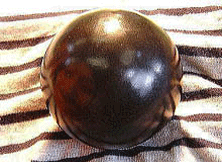
« PREVIOUS ENTRY
The rise of indie games: My latest Wired News gaming column
NEXT ENTRY »
Michael Landon and the squid

A few years ago, the Japanese educational theorist Fumia Kayo discovered that nursery-school children were obsessed with creating hikaru dorodango — balls of mud polished to such smoothness that they shine. Kayo started using an electron microscope to figure out precisely how mud could be made to shine best, and, as Web Japan reports, came up with the following technique:
1. Pack some mud into your hand, and squeeze out the water while forming a sphere.
2. Add some dry dirt to the outside and continue to gently shape the mud into a sphere.
3. When the mass dries, pack it solid with your hands, and rub the surface until a smooth film begins to appear.
4. Rub your hands against the ground, patting and rubbing the fine, powdery dirt onto the sphere. Continue this for two hours.
5. Seal the ball in a plastic bag for three or four hours. Upon removing the sphere, repeat step 4, and then once again seal the sphere in a plastic bag.
6. Remove the ball from the bag, and if it is no longer wet, polish it with a cloth until it shines.
Apparently this is now a national trend, and preschool children in Japan are busily making dorodango as we speak. Which is to say, preschool Japanese children are spending two hours polishing balls of mud! I love it.
Kayo has developed a 5-star rating system for the luster of the balls; that one pictured above rates a “4”. He’s got a “5” at home, and damned would I love to see it.
(Thanks to Ian Daly for this one!)
I'm Clive Thompson, the author of Smarter Than You Think: How Technology is Changing Our Minds for the Better (Penguin Press). You can order the book now at Amazon, Barnes and Noble, Powells, Indiebound, or through your local bookstore! I'm also a contributing writer for the New York Times Magazine and a columnist for Wired magazine. Email is here or ping me via the antiquated form of AOL IM (pomeranian99).

ECHO
Erik Weissengruber
Vespaboy
Terri Senft
Tom Igoe
El Rey Del Art
Morgan Noel
Maura Johnston
Cori Eckert
Heather Gold
Andrew Hearst
Chris Allbritton
Bret Dawson
Michele Tepper
Sharyn November
Gail Jaitin
Barnaby Marshall
Frankly, I'd Rather Not
The Shifted Librarian
Ryan Bigge
Nick Denton
Howard Sherman's Nuggets
Serial Deviant
Ellen McDermott
Jeff Liu
Marc Kelsey
Chris Shieh
Iron Monkey
Diversions
Rob Toole
Donut Rock City
Ross Judson
Idle Words
J-Walk Blog
The Antic Muse
Tribblescape
Little Things
Jeff Heer
Abstract Dynamics
Snark Market
Plastic Bag
Sensory Impact
Incoming Signals
MemeFirst
MemoryCard
Majikthise
Ludonauts
Boing Boing
Slashdot
Atrios
Smart Mobs
Plastic
Ludology.org
The Feature
Gizmodo
game girl
Mindjack
Techdirt Wireless News
Corante Gaming blog
Corante Social Software blog
ECHO
SciTech Daily
Arts and Letters Daily
Textually.org
BlogPulse
Robots.net
Alan Reiter's Wireless Data Weblog
Brad DeLong
Viral Marketing Blog
Gameblogs
Slashdot Games